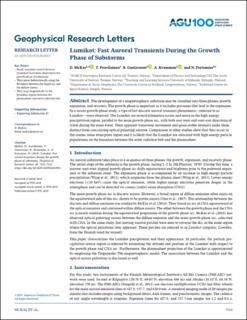| dc.contributor.author | McKay, Derek | |
| dc.contributor.author | Paavilainen, Tuula | |
| dc.contributor.author | Gustavsson, Björn Johan | |
| dc.contributor.author | Kvammen, Andreas | |
| dc.contributor.author | Partamies, Noora | |
| dc.date.accessioned | 2020-03-30T13:38:39Z | |
| dc.date.available | 2020-03-30T13:38:39Z | |
| dc.date.created | 2019-08-13T14:35:02Z | |
| dc.date.issued | 2019 | |
| dc.identifier.citation | Geophysical Research Letters. 2019, 46 (13), 7214-7221. | |
| dc.identifier.issn | 0094-8276 | |
| dc.identifier.uri | https://hdl.handle.net/11250/2649443 | |
| dc.description.abstract | The development of a magnetospheric substorm may be classified into three phases: growth, expansion, and recovery. The growth phase is important as it includes processes that lead to the expansion. In a recent growth-phase study, a type of fast discrete auroral transient phenomena -- referred to as Lumikot -- were observed. The Lumikot are several kilometers across and move in the high-energy precipitation region, parallel to the main growth-phase arc, with both east-west and west-east directions of travel during the same event. Their apparent transverse movement and quasi-stable intensity make them distinct from co-occurring optical pulsating aurorae. Comparison to other studies show that they occur in the cosmic noise absorption region and it is likely that the Lumikot are co-located with high-energy particle populations on the boundary between the outer radiation belt and the plasmasheet. | |
| dc.language.iso | eng | |
| dc.title | Lumikot: Fast auroral transients during the growth phase of substorms | |
| dc.type | Peer reviewed | |
| dc.type | Journal article | |
| dc.description.version | publishedVersion | |
| cristin.ispublished | true | |
| cristin.fulltext | original | |
| cristin.qualitycode | 2 | |
| dc.identifier.doi | 10.1029/2019GL082985 | |
| dc.identifier.cristin | 1715636 | |
| dc.source.journal | Geophysical Research Letters | |
| dc.source.volume | 46 | |
| dc.source.issue | 13 | |
| dc.source.pagenumber | 7214-7221 | |
| dc.relation.project | Norges forskningsråd: 223252 | |
